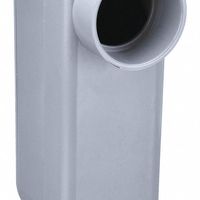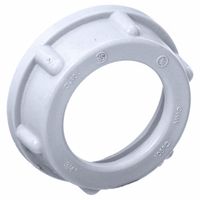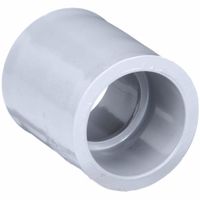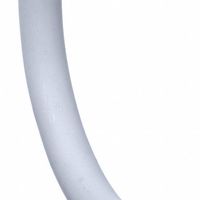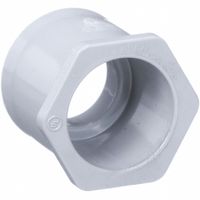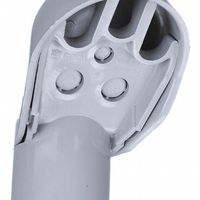Call +(254) 703 030 000 / 751 483 999 / 721 704 777
- Home
- Electrical
- Conduit Fittings Strut Channel Framing
- Conduit Fittings
- Pvc Conduit Fittings
.....Read More
Frequently Asked Questions
What is PVC conduit used for?
PVC conduit is used primarily for electrical installations to protect and route electrical wiring in various settings. It is made from polyvinyl chloride, a durable plastic material that offers several advantages for electrical applications. Here are the key uses and benefits of PVC conduit:
1. **Protection of Wires**: PVC conduit provides a protective layer around electrical wires, shielding them from physical damage, moisture, and corrosive elements. This is particularly important in environments where wires are exposed to harsh conditions.
2. **Insulation**: The non-conductive nature of PVC makes it an excellent insulator, reducing the risk of electrical shocks and short circuits. This property is crucial for maintaining safety in electrical systems.
3. **Flexibility and Versatility**: PVC conduit is available in various sizes and can be easily cut and shaped to fit different installation requirements. It can be used in both indoor and outdoor applications, including residential, commercial, and industrial settings.
4. **Cost-Effectiveness**: Compared to metal conduits, PVC is generally more affordable and easier to install, reducing labor and material costs. Its lightweight nature also simplifies transportation and handling.
5. **Corrosion Resistance**: Unlike metal conduits, PVC does not rust or corrode, making it ideal for use in damp or corrosive environments, such as underground installations or chemical plants.
6. **Fire Resistance**: PVC conduit is designed to be flame-retardant, helping to prevent the spread of fire along electrical installations.
7. **Compliance with Standards**: PVC conduits are manufactured to meet specific industry standards and codes, ensuring they provide reliable and safe performance in electrical systems.
Overall, PVC conduit is a practical and efficient solution for protecting and managing electrical wiring, offering a combination of safety, durability, and cost-effectiveness.
How do you bend PVC conduit?
To bend PVC conduit, follow these steps:
1. **Gather Tools and Materials**: You'll need a PVC conduit, a heat source (such as a heat gun or hairdryer), a bending spring or sand, and a marker.
2. **Measure and Mark**: Determine where the bend is needed and mark the conduit with a marker. Use a measuring tape for accuracy.
3. **Insert Bending Spring or Sand**: If using a bending spring, insert it into the conduit to prevent kinking. Alternatively, fill the conduit with sand, sealing both ends with tape to maintain shape.
4. **Heat the Conduit**: Use a heat gun or hairdryer to evenly heat the marked area. Keep the heat source moving to avoid burning or melting the PVC. The conduit should become flexible but not too soft.
5. **Bend the Conduit**: Once pliable, gently bend the conduit to the desired angle. Use a bending jig or a form to achieve precise angles if needed.
6. **Cool and Set**: Hold the conduit in place until it cools and retains the new shape. You can use a damp cloth to speed up the cooling process.
7. **Remove Bending Spring or Sand**: Once cooled, remove the bending spring or pour out the sand.
8. **Inspect the Bend**: Check for any kinks or deformities. The bend should be smooth and consistent.
9. **Install**: The bent conduit is now ready for installation.
Safety Tip: Always wear gloves and safety goggles to protect against heat and debris.
Can PVC conduit be used outdoors?
Yes, PVC conduit can be used outdoors. It is a popular choice for outdoor electrical installations due to its durability, resistance to moisture, and cost-effectiveness. PVC (Polyvinyl Chloride) conduit is non-conductive, which provides an added layer of safety by reducing the risk of electrical shock. It is also resistant to corrosion, making it suitable for various weather conditions, including rain and humidity.
When using PVC conduit outdoors, it is important to ensure that it is rated for sunlight resistance, as prolonged exposure to UV rays can degrade the material over time. Look for conduits labeled as "UV-resistant" or "sunlight-resistant" to ensure longevity. Additionally, PVC conduit is available in different thicknesses, with Schedule 40 and Schedule 80 being the most common. Schedule 80 is thicker and offers more protection, making it preferable for areas where the conduit might be exposed to physical damage.
Proper installation is crucial for outdoor use. Ensure that all joints and connections are securely sealed to prevent water ingress. Use appropriate fittings and adhesive designed for PVC to maintain a watertight seal. It is also advisable to bury the conduit underground where possible to protect it from physical damage and temperature fluctuations.
In summary, PVC conduit is suitable for outdoor use, provided it is UV-resistant and properly installed to withstand environmental conditions.
Is PVC conduit suitable for direct burial?
Yes, PVC conduit is suitable for direct burial. PVC (Polyvinyl Chloride) conduit is commonly used for underground electrical installations due to its durability, resistance to moisture, and non-corrosive properties. It is designed to protect electrical wires from physical damage and environmental factors when buried directly in the ground.
When using PVC conduit for direct burial, it is important to ensure that it is rated for such use. Schedule 40 and Schedule 80 PVC conduits are typically used for underground applications, with Schedule 80 offering thicker walls for added protection. The conduit should be buried at a depth that complies with local electrical codes, which often require a minimum depth of 18 inches for residential applications.
PVC conduit is also resistant to chemicals and does not conduct electricity, making it a safe choice for protecting electrical wiring. It is lightweight, easy to cut, and can be joined using solvent cement, which provides a watertight seal.
However, it is crucial to consider soil conditions and potential mechanical damage when installing PVC conduit underground. In areas with heavy traffic or rocky soil, additional protection such as concrete encasement or using a higher schedule conduit may be necessary.
Overall, PVC conduit is a practical and effective option for direct burial, provided it is installed correctly and in accordance with local regulations.
How do you join PVC conduit pieces together?
To join PVC conduit pieces together, follow these steps:
1. **Measure and Cut**: Measure the required length of the PVC conduit and cut it using a PVC pipe cutter or a hacksaw. Ensure the cut is straight and smooth.
2. **Deburr and Clean**: Use a deburring tool or a utility knife to remove any burrs or rough edges from the cut ends. Clean the ends with a cloth to remove dust and debris.
3. **Dry Fit**: Assemble the pieces without adhesive to ensure they fit properly. Make any necessary adjustments.
4. **Apply Primer**: Use a PVC primer to clean and soften the surfaces to be joined. Apply it to the outside of the conduit end and the inside of the fitting. Allow it to dry for a few seconds.
5. **Apply Cement**: Use PVC cement specifically designed for electrical conduit. Apply a thin, even layer to the primed areas of both the conduit and the fitting. Work quickly as the cement dries fast.
6. **Join the Pieces**: Immediately after applying the cement, insert the conduit into the fitting with a twisting motion to ensure even distribution of the cement. Push until the conduit bottoms out in the fitting.
7. **Hold in Place**: Hold the joint together for about 30 seconds to ensure the pieces bond properly and do not push apart.
8. **Wipe Excess Cement**: Use a cloth to wipe away any excess cement that may have squeezed out of the joint.
9. **Cure**: Allow the joint to cure as per the cement manufacturer's instructions before handling or applying any stress to the conduit.
10. **Inspect**: Check the joint for alignment and ensure it is secure.
These steps ensure a strong, durable connection between PVC conduit pieces.
What are the advantages of using PVC conduit?
PVC conduit offers several advantages:
1. **Corrosion Resistance**: PVC is resistant to corrosion from moisture, chemicals, and salts, making it ideal for both indoor and outdoor applications.
2. **Lightweight**: PVC conduits are lighter than metal conduits, making them easier to handle, transport, and install, reducing labor costs and time.
3. **Cost-Effective**: Generally, PVC is less expensive than metal alternatives, providing a cost-effective solution for electrical installations.
4. **Non-Conductive**: PVC is a non-conductive material, which enhances safety by reducing the risk of electrical shock.
5. **Durability**: PVC conduits are durable and can withstand physical impacts, reducing the likelihood of damage during installation and use.
6. **Flexibility**: PVC conduits offer some flexibility, which can be beneficial in installations where slight bending is required without the need for additional fittings.
7. **Fire Resistance**: PVC has a high resistance to fire and does not support combustion, adding an extra layer of safety in case of fire hazards.
8. **Smooth Interior**: The smooth interior surface of PVC conduits reduces friction, making it easier to pull wires through and minimizing the risk of damage to the wires.
9. **UV Resistance**: Some PVC conduits are UV-resistant, making them suitable for outdoor use where exposure to sunlight is a factor.
10. **Chemical Resistance**: PVC is resistant to a wide range of chemicals, making it suitable for use in industrial environments where exposure to chemicals is common.
11. **Low Thermal Conductivity**: PVC has low thermal conductivity, which helps in maintaining the temperature of the wires inside, reducing the risk of overheating.
12. **Environmentally Friendly**: PVC is recyclable, contributing to environmental sustainability efforts.
These advantages make PVC conduit a popular choice for a wide range of electrical installations.
What sizes does PVC conduit come in?
PVC conduit is available in a variety of sizes to accommodate different electrical and construction needs. The sizes are typically measured by the inside diameter of the conduit. Common sizes include:
- **1/2 inch**: Often used for residential applications and small projects.
- **3/4 inch**: Suitable for light commercial and residential wiring.
- **1 inch**: Used for larger residential projects and light commercial applications.
- **1 1/4 inch**: Common in commercial settings for moderate wiring needs.
- **1 1/2 inch**: Used for larger commercial projects and industrial applications.
- **2 inch**: Suitable for heavy-duty commercial and industrial wiring.
- **2 1/2 inch**: Used in industrial settings for large wiring bundles.
- **3 inch**: Common in large-scale industrial projects.
- **3 1/2 inch**: Used for very large wiring needs in industrial applications.
- **4 inch**: Suitable for major industrial and infrastructure projects.
PVC conduit is also available in larger sizes, such as 5 inch, 6 inch, and beyond, for specialized industrial applications. The choice of size depends on the number and size of the wires or cables to be housed, as well as the specific requirements of the project.
